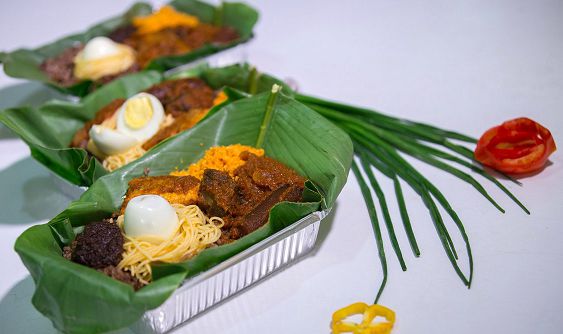
‘Green leaf: Best for food packaging’
“The green leaf is best for food packaging for healthy living, and how I wish it never fades away,” an Octogenarian and the Chief of Kronteng in the Nkwanta South District has stated.
Food packaged in green leaves or earthenware was one of the best dishes the aged preferred to be served with until now.
Some of the leaves used in packaging foods are those of plantain and pawpaw.
Various type of foods such as waakye, beans, rice, ‘Kafa,’ ‘Tuo-zaafi,’ Banku, kenkey and “apapransa” can be served in leaves.
Today, thin plastic bags and styrofoam packs are the preferred containers for food packaging because of their convenience.
However, Chief Alegbe, 83, believes that the increasing spate of cancer in the country in recent years could partly be attributed to the chemical composition of the rubber or styrofoam packs used in serving food for consumers.
Danger
Advertisement
The Head of the Food Inspectorate Division of the Food and Drugs Authority (FDA), Mr Kofi Essel, has attested to the chief’s claims, stressing that regular eating from polythene can cause stomach cancer.
He described the act of eating from polythene as inappropriate due to particles that could be derived from the rubber receptacle into foods that were virtually consumed.
“Most people are careless or ignorant on the health implications of this act. Chemicals from polythene often leach into foods, especially chemicals can easily dissolve into cooked oily foods, and this can have serious health implications on consumers,” the officer added.
The Chair, Media and Apologetics Committee of the Ghana Dietetics Association and a lecturer at the University of Health and Allied Sciences (UHAS), Nana Kofi Owusu, also affirmed that eating hot foods from plastics could cause cancer and other health complications, especially in children under three years due to bisphenol (an industrial chemical added to products, including plastic food containers) that could seep into hot foods.
According to Mr Owusu, polythene bags were made up of carbon compounds and therefore when those particles got into the stomach, can cause stomach cancer.
He added that soft black polythene and light rubber used for packaging of hot porridge and banku for longer periods could be dangerous to a consumer’s health.
Mr Owusu also said consuming frozen foods in polythene could also pose danger to the health of consumers, especially in young children and pregnant women.
He added that putting take away packs in microwaves till the food burns is not very healthy therefore must be avoided.
"There is scientific evidence of some loss of antioxidants when food is microwaved for a long period.
It is important to use microwave bowls which are tough enough to prevent residue deposition.
And microwaving should be done in short periods,” the officer stated.
He further cautioned consumers against the use of expired microwaves, saying: “The other thing about microwave is its expiration.
An expired microwave causes destruction to the net covering the bulb which can lead to increased leakages of waves into foods.”
Advice
Even though Mr Owusu encouraged the use of leaves for food packaging because of the flavour they offered and some polyphenols and isoflavonoids which act as antioxidants, “it must be well cleaned by washing to prevent bacteria and worm contaminations.”
For those who still prefer plastic receptacles for packaging of food, he asked them to use hard rubber containers rather than polythene.
He also advised on the use polythene for "banku" pakaging.
“Avoid using polythene to wrap hot banku" and put down for a long period, also avoid using rubber round fante kenkey before using plantain leaves and then boiling on fire for long hours.”
A lab Technician from MEDILAB, Mrs Gloria Tamaklo also advised individuals ready to eat hot food at a go to carry their personal bowls than hot packaged foods in take-away, or soft black and white polythene bags.
Mrs Tamaklo advised that we go for the “waakye” leaf or carry our own bowls when buying hot foods.
“I will advise that we go for clean green leaves instead or carry our own bowls to food vendors. For the plastics, we know plastics are made of chemicals so when in contact with heat from food, the chemicals seep into the food. Therefore the green leaves are better.
“They must however be well cleaned by washing to prevent bacteria and worm contamination,” he said.
According to these experts, the best way of packaging hot foods is either in hard plastics or clean leaves packaged in takeaway for good health and easy movement.

Plastics
Plastics are man-made organic materials that are produced from oil and natural gas.
It consists of large molecules (macromolecules), the building blocks for all materials.
The molecular weights of plastics may vary from about 20, 000 to 100,000 mg/L.
Plastics include Polyethylene (LDPE), used in the manufacture of film bags, sacks and sheeting, blow-moulded bottles, food boxes, flexible piping and hosepipes among others.
Polypropylene is also used for items such as stools and chairs, high-quality home ware, car battery housing, domestic appliances, suitcases and wine barrels while Polystyrene, in its unprocessed form, is brittle and usually transparent.
It is used for cheap, transparent kitchen ware, light fittings, bottles, toys and food containers among other items.
The other type of plastic is Polyvinyl chloride, which is used in making bottles, thin sheeting, transparent packaging materials, water and irrigation pipes, gutters, window frames and building panels among others.
Writer's email- [email protected]



